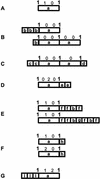Signatures of domain shuffling in the human genome
- PMID: 12421750
- PMCID: PMC187552
- DOI: 10.1101/gr.520702
Signatures of domain shuffling in the human genome
Abstract
To elucidate the role of exon shuffling in shaping the complexity of the human genome/proteome, we have systematically analyzed intron phase distributions in the coding sequence of human protein domains. We found that introns at the boundaries of domains show high excess of symmetrical phase combinations (i.e., 0-0, 1-1, and 2-2), whereas nonboundary introns show no excess symmetry. This suggests that exon shuffling has primarily involved rearrangement of structural and functional domains as a whole. Furthermore, we found that domains flanked by phase 1 introns have dramatically expanded in the human genome due to domain shuffling and that 1-1 symmetrical domains and domain families are nonrandomly distributed with respect to their age. The predominance and extracellular location of 1-1 symmetrical domains among domains specific to metazoans suggests that they are associated with the rise of multicellularity. On the other hand, 0-0 symmetrical domains tend to be over-represented among ancient protein domains that are shared between the eukaryotic and prokaryotic kingdoms, which is compatible with the suggestion of primordial domain shuffling in the progenote. To see whether the human data reflect general genomic patterns of metazoans, similar analyses were done for the nematode Caenorhabditis elegans. Although the C. elegans data generally concur with the human patterns, we identified fewer intron-bounded domains in this organism, consistent with the lower complexity of C. elegans genes. [The following individuals kindly provided reagents, samples, or unpublished information as indicated in the paper: Z. Gu and R. Stevens.]
Figures


Similar articles
-
Signs of ancient and modern exon-shuffling are correlated to the distribution of ancient and modern domains along proteins.J Mol Evol. 2005 Sep;61(3):341-50. doi: 10.1007/s00239-004-0318-y. Epub 2005 Jul 18. J Mol Evol. 2005. PMID: 16034650
-
Significant expansion of exon-bordering protein domains during animal proteome evolution.Nucleic Acids Res. 2005 Jan 7;33(1):95-105. doi: 10.1093/nar/gki152. Print 2005. Nucleic Acids Res. 2005. PMID: 15640447 Free PMC article.
-
Protein domains correlate strongly with exons in multiple eukaryotic genomes--evidence of exon shuffling?Trends Genet. 2004 Sep;20(9):399-403. doi: 10.1016/j.tig.2004.06.013. Trends Genet. 2004. PMID: 15313546 Review.
-
Evolutionary history of exon shuffling.Genetica. 2012 Jun;140(4-6):249-57. doi: 10.1007/s10709-012-9676-3. Epub 2012 Sep 5. Genetica. 2012. PMID: 22948334
-
Directed evolution of proteins by exon shuffling.Nat Biotechnol. 2001 May;19(5):423-8. doi: 10.1038/88084. Nat Biotechnol. 2001. PMID: 11329010 Review.
Cited by
-
A new Drosophila spliceosomal intron position is common in plants.Proc Natl Acad Sci U S A. 2003 May 27;100(11):6580-3. doi: 10.1073/pnas.0731952100. Epub 2003 May 15. Proc Natl Acad Sci U S A. 2003. PMID: 12750476 Free PMC article.
-
Evolutionary dynamics of spliceosomal intron revealed by in silico analyses of the P-Type ATPase superfamily genes.Mol Biol Rep. 2011 Apr;38(4):2285-93. doi: 10.1007/s11033-010-0360-3. Epub 2010 Nov 3. Mol Biol Rep. 2011. PMID: 21046256
-
Origin and evolution of new exons in rodents.Genome Res. 2005 Sep;15(9):1258-64. doi: 10.1101/gr.3929705. Epub 2005 Aug 18. Genome Res. 2005. PMID: 16109974 Free PMC article.
-
A general definition and nomenclature for alternative splicing events.PLoS Comput Biol. 2008 Aug 8;4(8):e1000147. doi: 10.1371/journal.pcbi.1000147. PLoS Comput Biol. 2008. PMID: 18688268 Free PMC article.
-
Computer analysis of protein functional sites projection on exon structure of genes in Metazoa.BMC Genomics. 2015;16 Suppl 13(Suppl 13):S2. doi: 10.1186/1471-2164-16-S13-S2. Epub 2015 Dec 16. BMC Genomics. 2015. PMID: 26693737 Free PMC article.
References
-
- Andrade MA, Perez-Iratxeta C, Ponting CP. Protein repeats: Structures, functions, and evolution. J Struct Biol. 2001;134:117–131. - PubMed
-
- Beckmann G, Bork P. An adhesive domain detected in functionally diverse receptors. Trends Biochem Sci. 1993;18:40–41. - PubMed
-
- Cavalier-Smith T. Selfish DNA and the origin of introns. Nature. 1985;315:283–284. - PubMed
Publication types
MeSH terms
Substances
Grants and funding
LinkOut - more resources
Full Text Sources
Other Literature Sources
